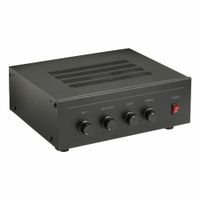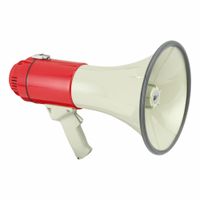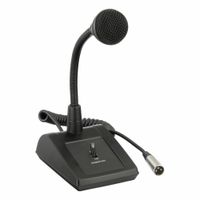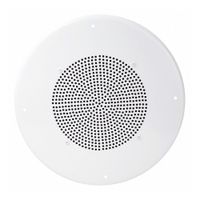Call +(254) 703 030 000 / 751 483 999 / 721 704 777
- Home
- Electronics Batteries
- Electronic Communication Equipment
- Audio Equipment
- Speakers Public Address Equipment
.....Read More
Frequently Asked Questions
What are the best speakers for public address systems?
The best speakers for public address systems are those that offer clarity, power, and durability. Here are some top choices:
1. **JBL Professional EON615**: Known for its clear sound and robust build, this 15-inch speaker offers 1000 watts of power, making it suitable for both indoor and outdoor events. It features Bluetooth connectivity for easy control and setup.
2. **Electro-Voice ZLX-12P**: This 12-inch powered speaker is praised for its sound quality and affordability. It provides 1000 watts of power and has a lightweight design, making it easy to transport and set up.
3. **QSC K12.2**: Offering 2000 watts of power, the K12.2 is renowned for its exceptional sound clarity and versatility. It includes advanced DSP settings for different environments and applications, ensuring optimal performance.
4. **Yamaha DXR15**: With 1100 watts of power, this 15-inch speaker is known for its reliability and sound quality. It features a rugged design and advanced DSP for enhanced sound control.
5. **Bose F1 Model 812**: This flexible array speaker provides 1000 watts of power and allows for adjustable coverage patterns, making it ideal for various venues. It delivers clear and powerful sound with Bose's renowned audio quality.
6. **Mackie Thump15A**: Offering 1300 watts of power, this 15-inch speaker is budget-friendly and provides deep bass and clear highs. It is lightweight and easy to set up, making it a popular choice for mobile DJs and small events.
When choosing speakers for a public address system, consider factors such as venue size, indoor or outdoor use, portability, and budget. These options provide a balance of power, clarity, and reliability, making them suitable for a wide range of public address applications.
How do I choose the right amplifier for my PA system?
1. **Determine Power Requirements**: Calculate the total power needed by considering the size of the venue and the number of speakers. Match the amplifier's power output to the speakers' power handling capacity, ensuring it is 1.5 to 2 times the speaker's RMS rating for optimal performance.
2. **Impedance Matching**: Ensure the amplifier's output impedance matches the speaker's impedance (usually 4, 8, or 16 ohms) to prevent damage and ensure efficient power transfer.
3. **Number of Channels**: Choose an amplifier with enough channels to support your speaker setup. A stereo amplifier is suitable for two speakers, while multi-channel amplifiers are needed for larger setups.
4. **Type of Amplifier**: Decide between a Class A, B, AB, or D amplifier. Class D amplifiers are popular for PA systems due to their efficiency and lighter weight.
5. **Connectivity Options**: Ensure the amplifier has the necessary input and output connections for your system, such as XLR, RCA, or 1/4-inch jacks.
6. **Portability and Size**: Consider the size and weight of the amplifier, especially if the system needs to be mobile. Rack-mounted amplifiers are ideal for fixed installations.
7. **Budget**: Set a budget that balances quality and affordability. Higher-end models offer better sound quality and durability but at a higher cost.
8. **Brand and Reliability**: Choose reputable brands known for reliability and good customer support. Check reviews and user feedback.
9. **Additional Features**: Look for features like built-in limiters, crossovers, and equalizers that can enhance performance and protect your equipment.
10. **Future Expansion**: Consider future needs and choose an amplifier that can accommodate additional speakers or upgrades.
What is the difference between active and passive speakers?
Active speakers have built-in amplifiers, meaning they can be directly connected to audio sources without needing an external amplifier. They often include additional features like equalizers, Bluetooth connectivity, and volume controls. This integration makes them convenient and user-friendly, as they require fewer components and cables. Active speakers are commonly used in home audio systems, studio monitors, and portable speaker setups.
Passive speakers, on the other hand, do not have built-in amplifiers and require an external amplifier or receiver to power them. This setup allows for more customization and flexibility in terms of choosing amplifiers and other audio components. Passive speakers are often preferred by audiophiles and professionals who want to tailor their audio systems to specific preferences or environments. They are typically used in home theater systems, professional audio setups, and large venues.
In summary, the main difference lies in the presence of an internal amplifier in active speakers, which simplifies setup and use, versus the need for an external amplifier with passive speakers, offering more customization options.
How do I properly set up a PA system for optimal sound quality?
1. **Assess the Venue**: Understand the size, shape, and acoustics of the venue. Identify potential obstacles and reflective surfaces that might affect sound.
2. **Select Equipment**: Choose appropriate speakers, amplifiers, mixers, and microphones based on the venue size and event type. Ensure compatibility and sufficient power handling.
3. **Speaker Placement**: Position speakers to cover the audience evenly. Elevate them above head level to avoid obstructions. Use speaker stands or fly them if possible. Avoid placing speakers too close to walls to reduce reflections.
4. **Microphone Setup**: Use directional microphones to minimize feedback. Position them away from speakers and monitors. For vocal clarity, maintain a consistent distance from the microphone.
5. **Cabling and Connections**: Use high-quality cables and connectors. Keep power and audio cables separate to avoid interference. Secure cables to prevent tripping hazards.
6. **Mixer Configuration**: Set up the mixer with appropriate input levels. Use the gain control to set the initial input level, then adjust faders for overall mix balance. Utilize EQ to tailor the sound to the venue.
7. **Monitor Setup**: Position monitors for performers to hear themselves clearly without causing feedback. Adjust monitor levels separately from the main mix.
8. **Sound Check**: Conduct a thorough sound check with all equipment and performers. Adjust levels, EQ, and monitor mixes as needed. Walk the venue to ensure even sound distribution.
9. **Feedback Control**: Use a graphic equalizer or feedback suppressor to identify and reduce feedback frequencies. Keep microphone levels in check and avoid excessive gain.
10. **Final Adjustments**: Make final tweaks during the event as needed, monitoring audience reactions and adjusting for any changes in acoustics or dynamics.
What are the key features to look for in a microphone for public address?
When selecting a microphone for public address (PA) systems, consider the following key features:
1. **Type**: Choose between dynamic and condenser microphones. Dynamic mics are durable and handle high sound pressure levels, making them ideal for live events. Condenser mics offer better sound quality and sensitivity, suitable for quieter environments.
2. **Polar Pattern**: Cardioid patterns are common for PA systems as they capture sound from the front and reject noise from the sides and rear, reducing feedback. Supercardioid and hypercardioid patterns offer even more directionality.
3. **Frequency Response**: Look for a microphone with a frequency response that matches the intended use. A flat response is versatile, while tailored responses can enhance specific vocal or instrumental qualities.
4. **Sensitivity**: Higher sensitivity microphones capture more detail but may also pick up unwanted noise. Balance sensitivity with the environment and application.
5. **Durability**: Consider the build quality, especially for dynamic mics, which are often used in rugged environments. Metal casings and robust construction are preferable.
6. **Connectivity**: Ensure compatibility with your PA system. XLR connections are standard for professional setups, offering balanced audio and reduced interference.
7. **Impedance**: Low-impedance microphones (below 600 ohms) are preferred for long cable runs and professional applications, minimizing signal loss.
8. **Feedback Rejection**: Features like built-in shock mounts and pop filters can help reduce handling noise and plosives, improving clarity.
9. **Wireless Options**: For mobility, consider wireless microphones. Ensure they have a reliable transmission range and battery life suitable for the event duration.
10. **Cost**: Balance your budget with the required features. Higher-end models offer better sound quality and durability but may not be necessary for all applications.
How can I prevent feedback in my PA system?
To prevent feedback in a PA system, follow these steps:
1. **Microphone Placement**: Position microphones behind the main speakers to avoid sound from the speakers being picked up by the microphones. Use directional microphones to focus on the sound source and reject off-axis noise.
2. **Speaker Placement**: Place speakers in front of the microphones and at an appropriate height to project sound over the audience, not directly at the microphones.
3. **Monitor Management**: Use in-ear monitors instead of floor monitors to reduce stage volume. If floor monitors are necessary, angle them correctly and keep them at a low volume.
4. **Gain Structure**: Set the gain levels properly. Start with the microphone gain low and gradually increase it to the desired level without causing feedback.
5. **Equalization**: Use a graphic equalizer to cut frequencies that are prone to feedback. Identify and reduce problematic frequencies by using a feedback detection system or by ear.
6. **Feedback Suppressors**: Implement automatic feedback suppressors that detect and notch out feedback frequencies.
7. **Volume Control**: Keep the overall volume at a reasonable level. Avoid excessive amplification that can lead to feedback.
8. **Room Acoustics**: Treat the room acoustically to minimize reflections. Use sound-absorbing materials like curtains, carpets, and acoustic panels.
9. **Microphone Technique**: Train performers to use proper microphone techniques, such as holding the microphone close to their mouth and avoiding pointing it towards speakers.
10. **System Check**: Regularly check and maintain the PA system to ensure all components are functioning correctly and are properly configured.
By implementing these strategies, you can significantly reduce the likelihood of feedback in your PA system.
What are the best practices for maintaining and storing PA equipment?
1. **Regular Cleaning**: Dust and dirt can affect performance. Use a soft, dry cloth for cleaning surfaces and compressed air for hard-to-reach areas.
2. **Proper Storage**: Store equipment in a cool, dry place. Use padded cases or covers to protect from physical damage and environmental factors.
3. **Cable Management**: Use cable ties or Velcro straps to organize cables. Avoid sharp bends and ensure cables are not under tension to prevent damage.
4. **Routine Inspection**: Regularly check for wear and tear, loose connections, and any signs of damage. Address issues immediately to prevent further damage.
5. **Moisture Control**: Keep equipment away from moisture. Use silica gel packs in storage cases to absorb humidity.
6. **Power Management**: Use surge protectors to prevent damage from power surges. Ensure proper grounding to avoid electrical issues.
7. **Battery Care**: For battery-operated equipment, remove batteries when not in use for extended periods to prevent leakage. Regularly charge and discharge rechargeable batteries to maintain their lifespan.
8. **Temperature Control**: Avoid exposing equipment to extreme temperatures. Allow equipment to acclimate to room temperature before use if moved from a different environment.
9. **Professional Servicing**: Schedule regular maintenance with professionals to ensure equipment is in optimal condition.
10. **Documentation**: Keep manuals and warranty information accessible. Maintain a log of maintenance and repairs for reference.
11. **Training**: Ensure all users are trained in proper handling and operation to minimize misuse and accidental damage.
12. **Labeling**: Clearly label all equipment and cables to prevent confusion and ensure correct setup and operation.




